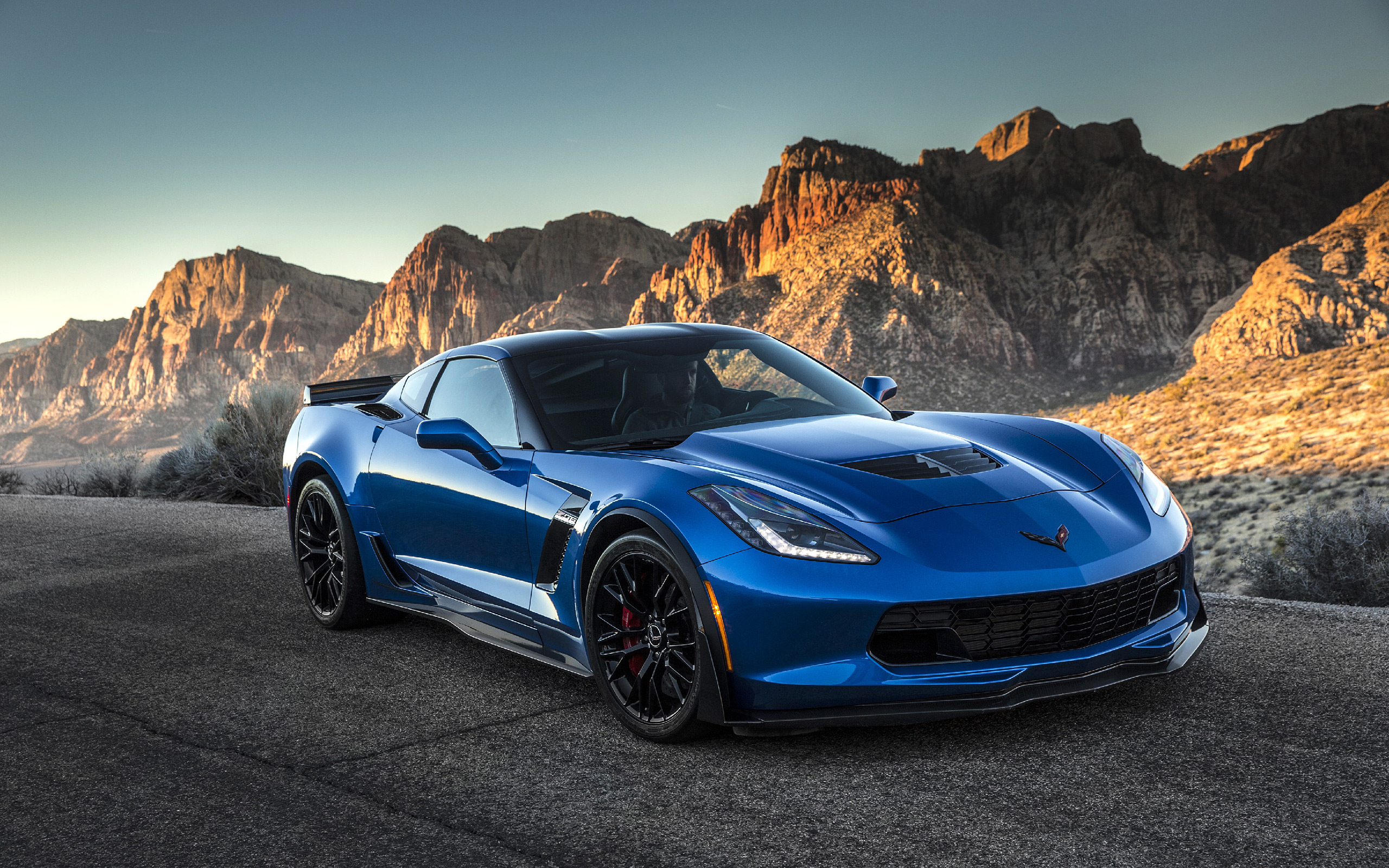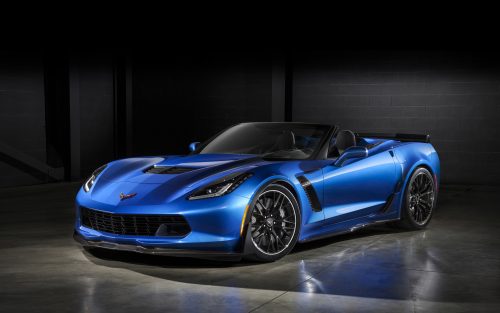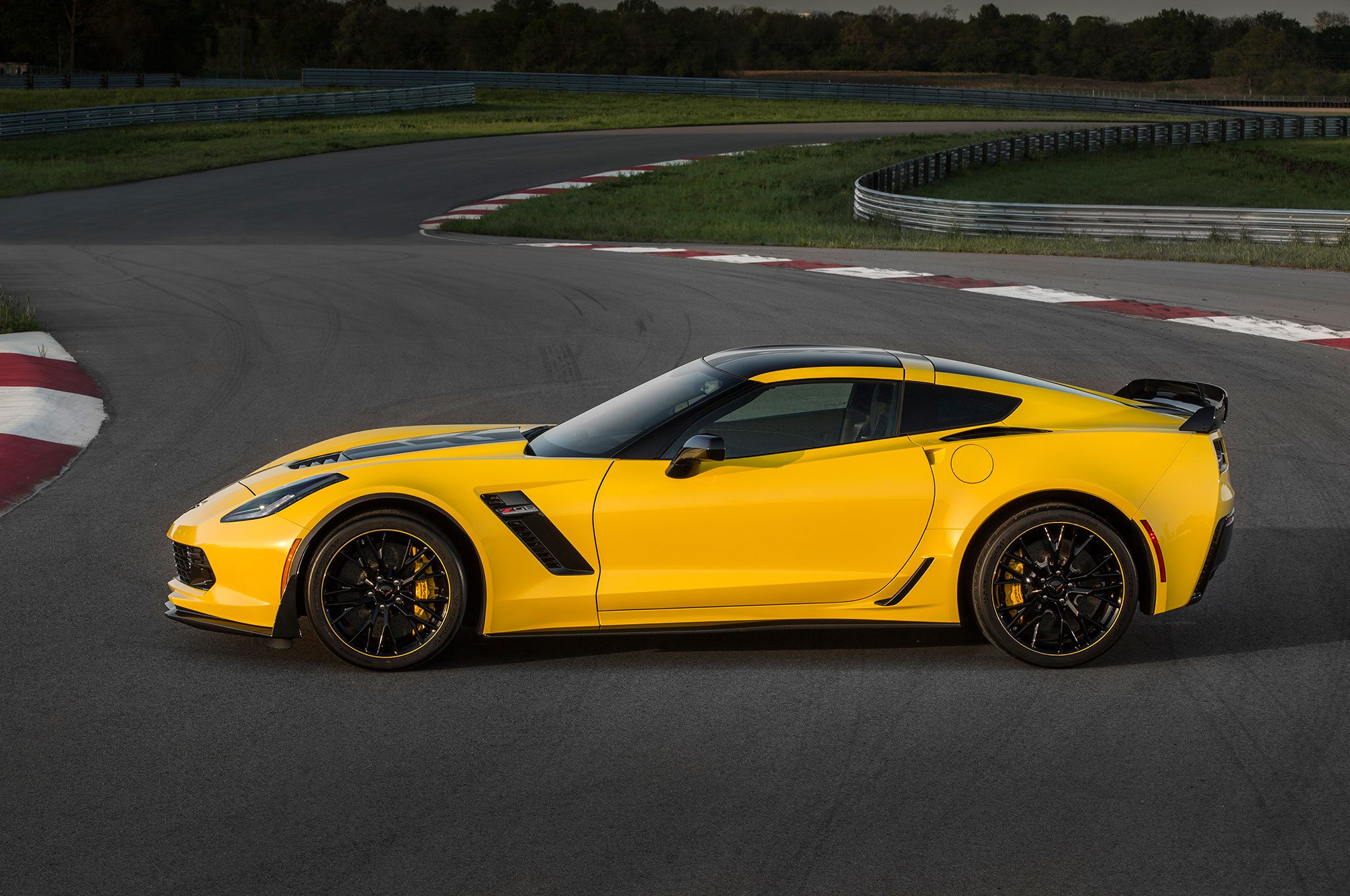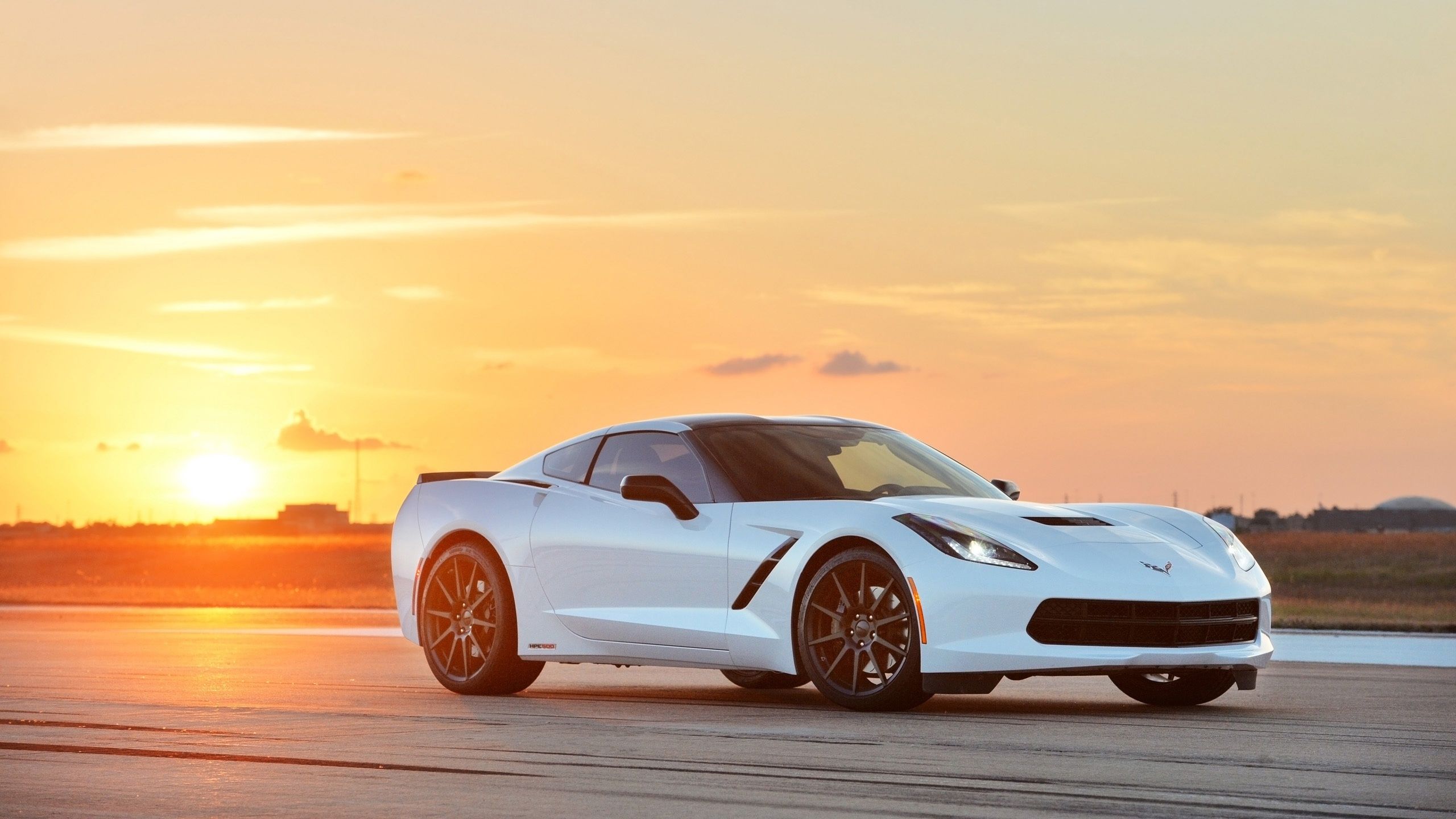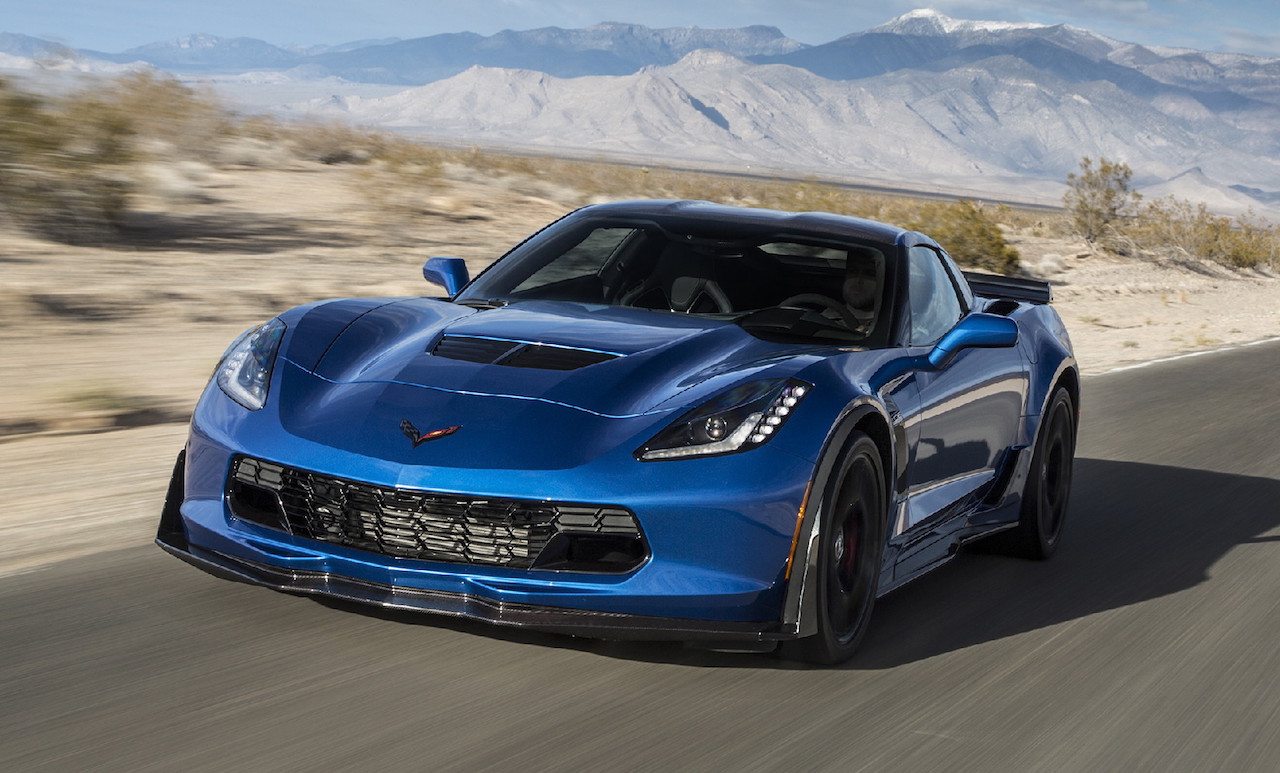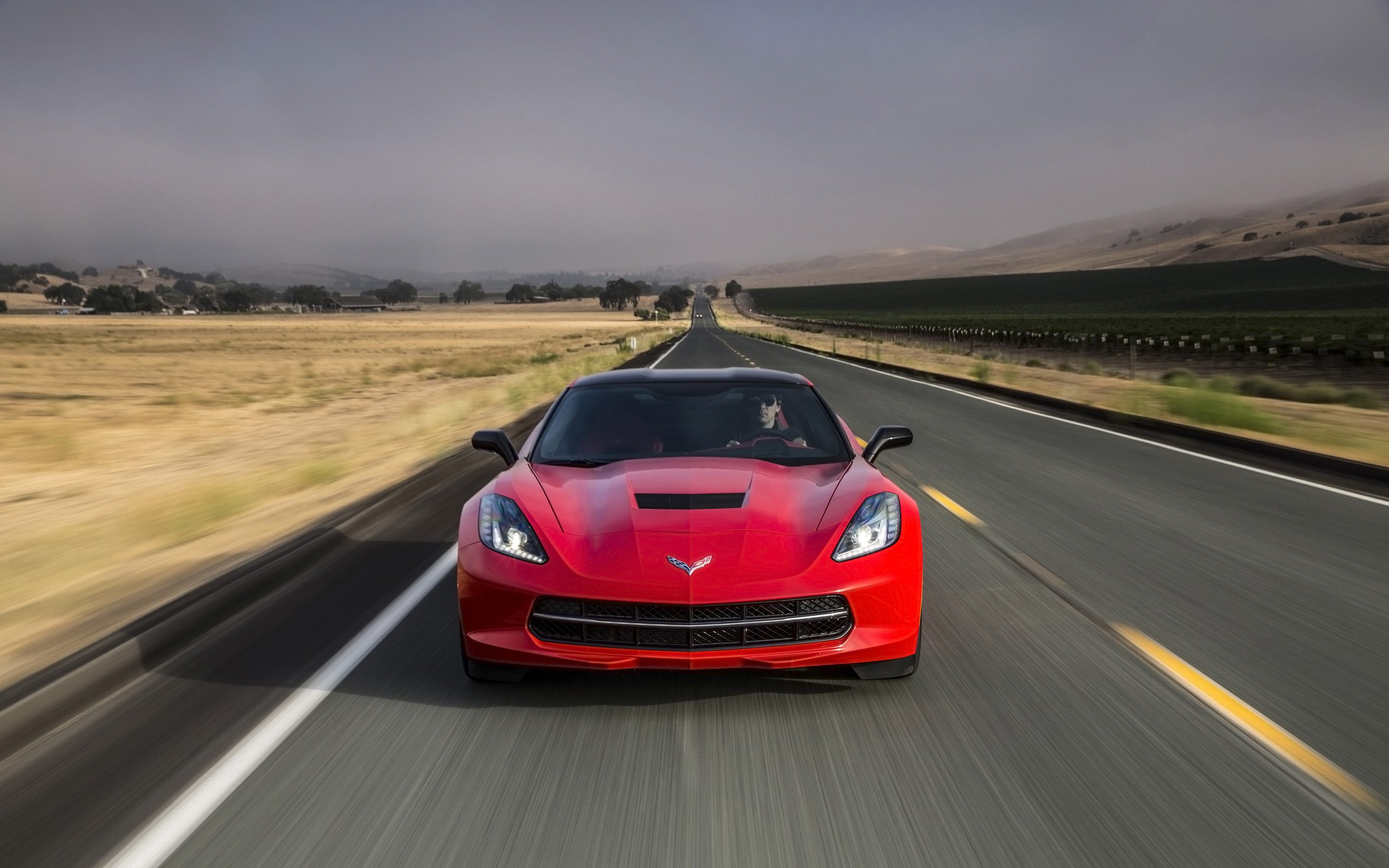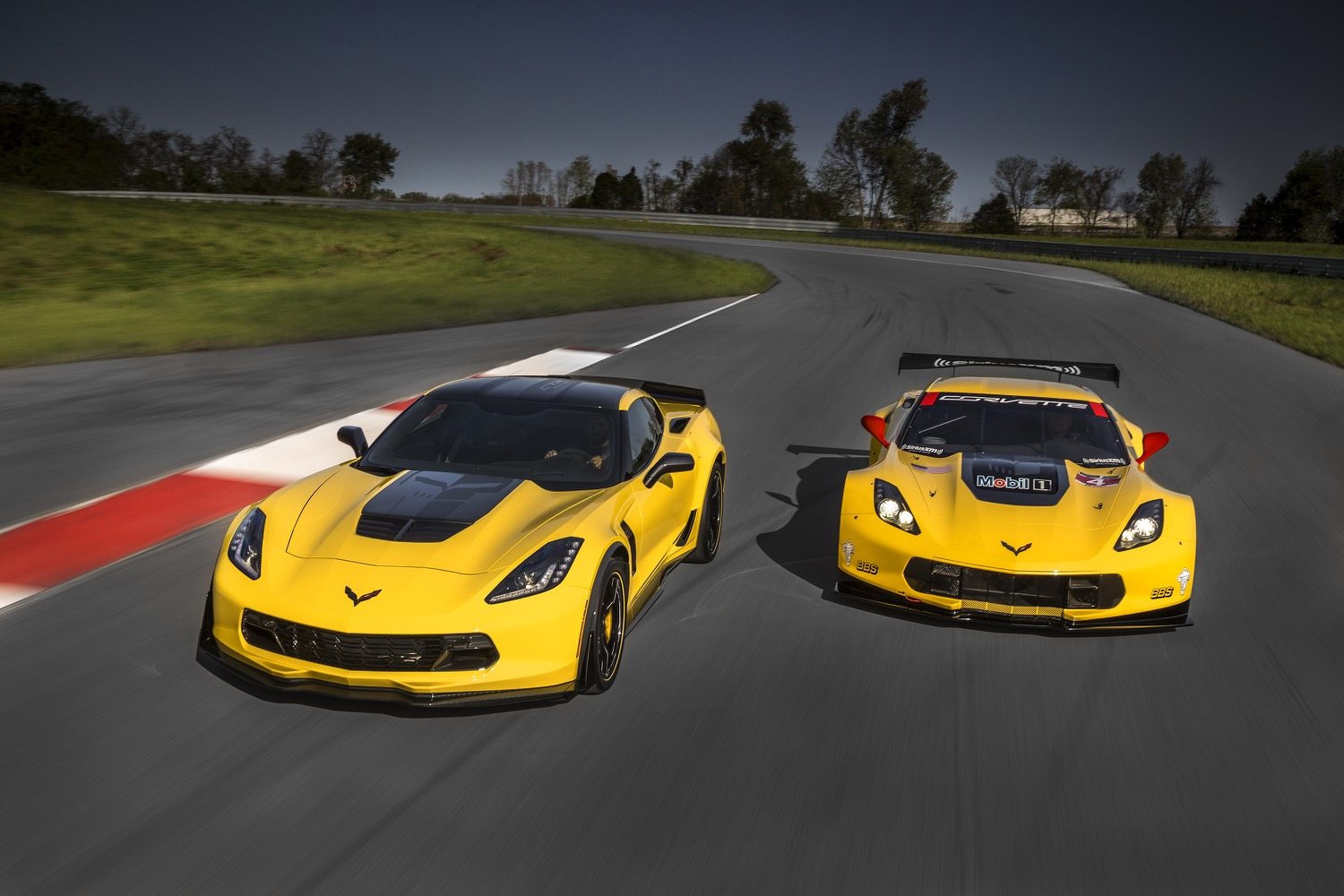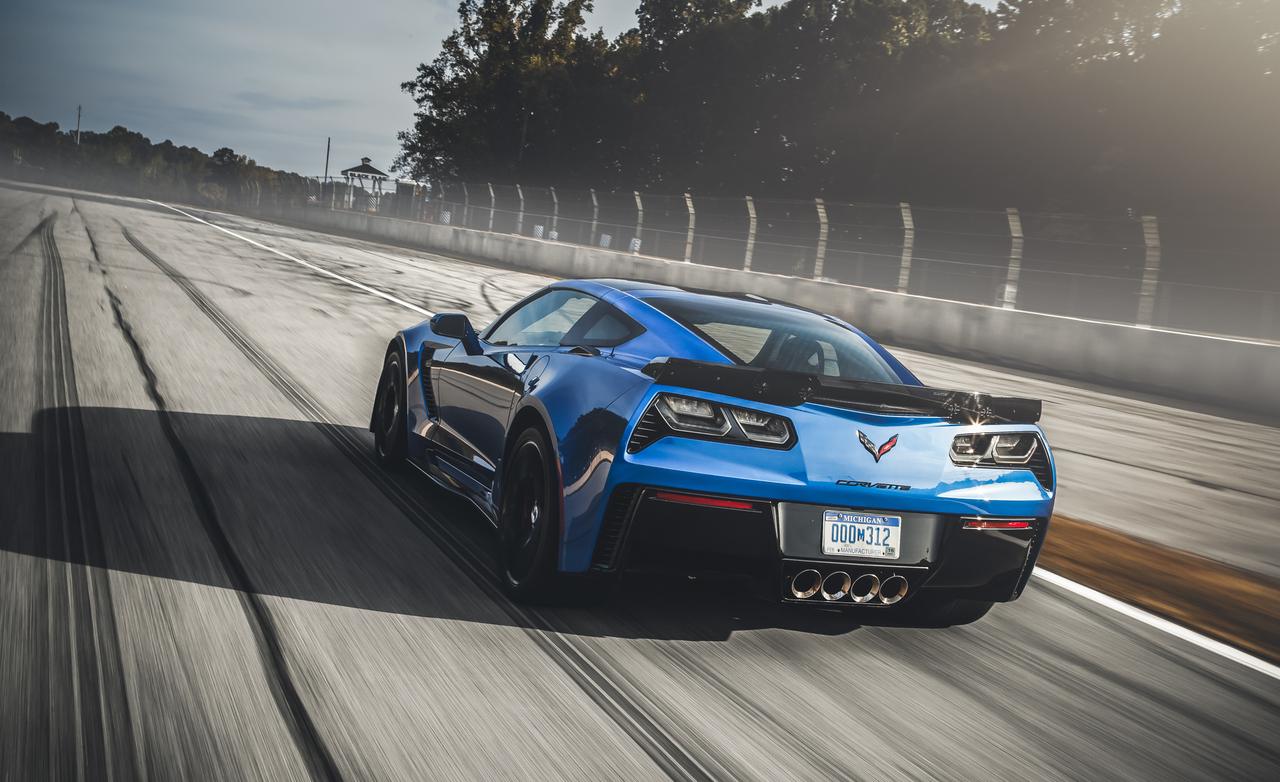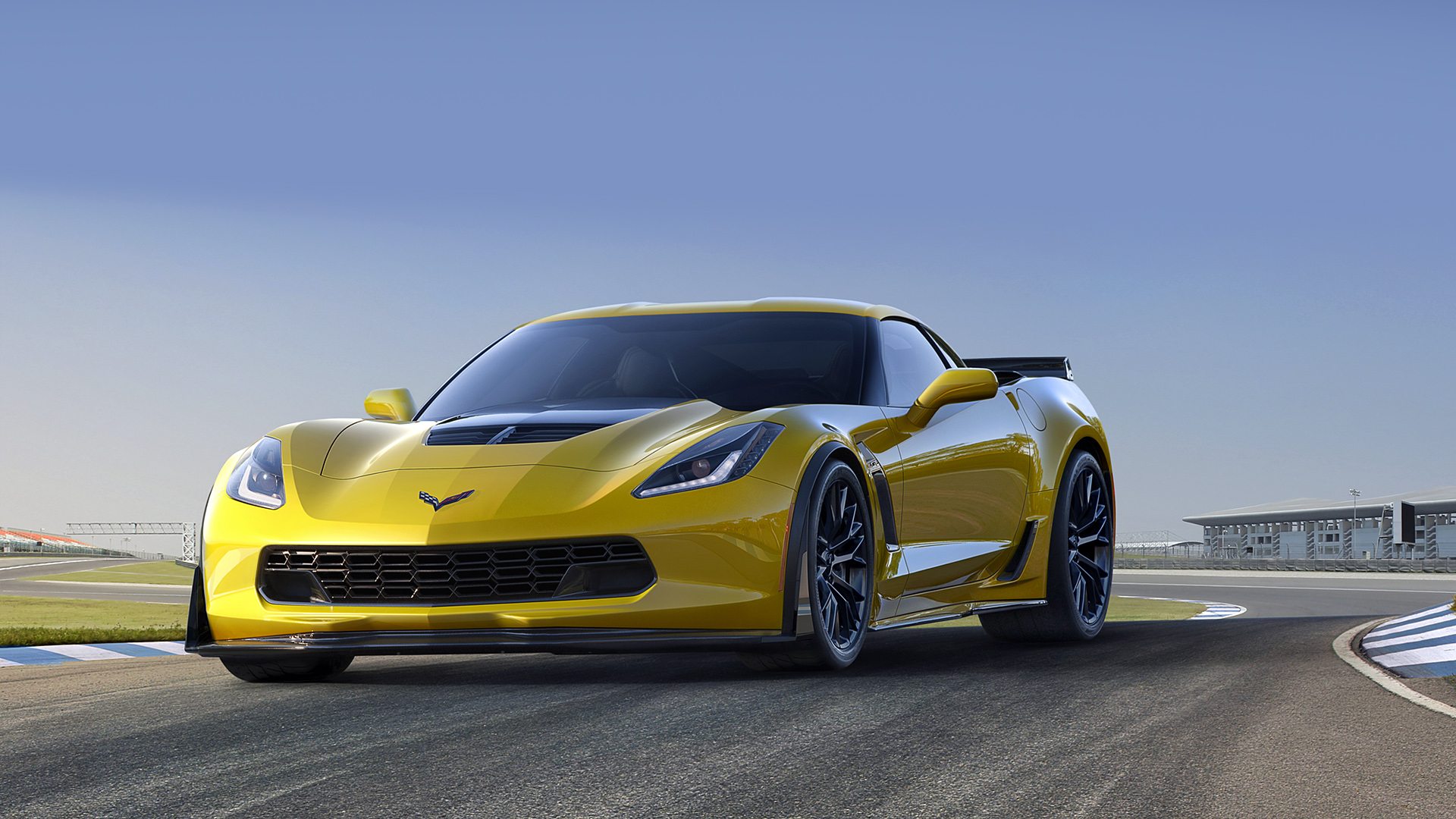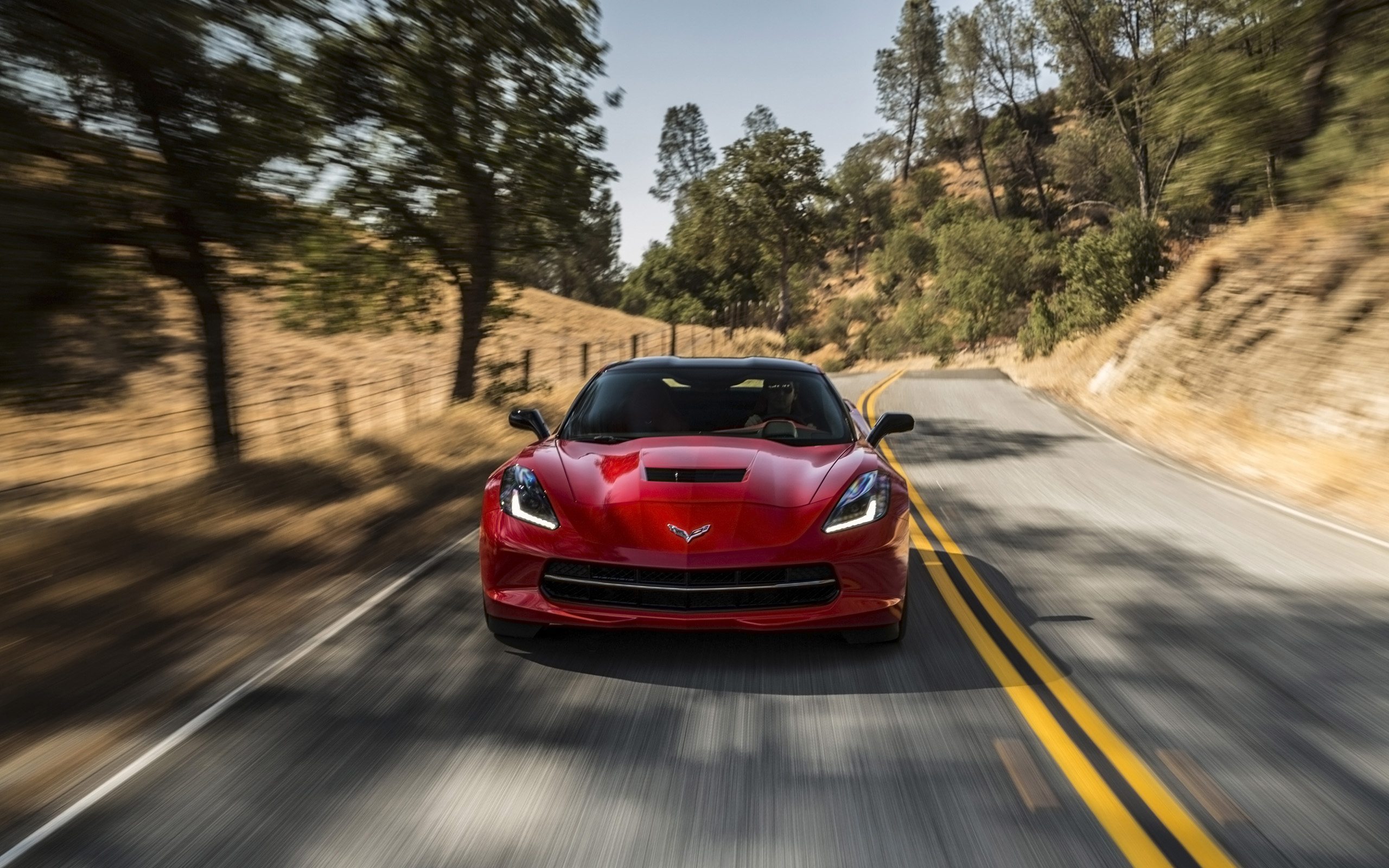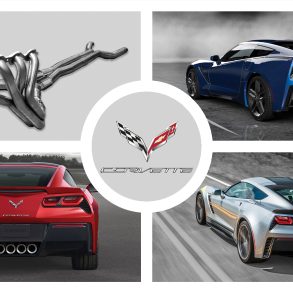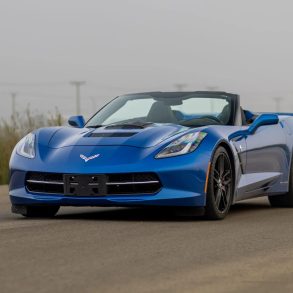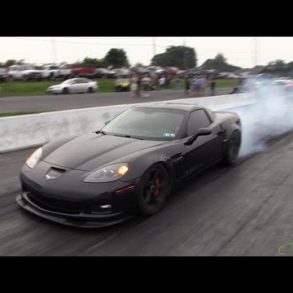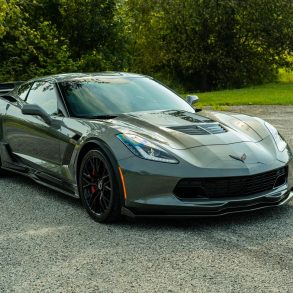2015 Corvette – The Ultimate Guide
The introduction of the all-new seventh-generation Corvette Stingray in 2014 changed the global perception of the Corvette from being a “better than average” American Sports Car to a performance driven, form-follows-function super-car capable of competing on the world stage.
The C7 Corvette Stingray was recognized by both enthusiasts and critics alike for its uncompromising performance, its vastly superior “fit and finish” (compared to earlier generations of Corvette), and its well-appointed cockpit and command center. By the end of 2014, the new Corvette Stingray became the most-awarded car of the year, including being named the “2014 North American Car of the Year!”
Never one to rest on their laurels, Chevrolet knew that the 2015 Corvette Stingray would have to be even better. After all, earlier generations of the Corvette – going back to the second-generation Corvette Stingray – had special edition variants, and higher performance production models that could provide consumers with blistering speed and track-ready performance.
The seventh-generation Corvette would be no different.
For its sophomore year, Chevrolet was prepared to roll out a considerable number of enhancements to the Stingray, including an all-new transmission, two new design packages, and a Z06 Corvette variant that would surpass any Corvette that had come before it in both power and performance.
The Atlantic and Pacific Design Packages
When considering what enhancements were important to consumers, the design team behind 2015 Stingray recognized that the Corvette needed to cater to the varying desires of those purchasing the car. To gain perspective on public interest in the car, two unique Corvette Stingrays were introduced in the 2014 SEMA show. The response to these cars was strong, and led the designers to realize the potential for customizing the Corvette to better suit consumer interest.
The result of this realization was the introduction of two new and distinctive design packages – the Atlantic and Pacific Design Packages. Each package is unique from the other and show the personalization range of the Corvette Stingray. At one end of the spectrum, the Corvette could be configured as a luxury sports GT car (the Atlantic Design Package) or as a high-performance motorsport car (the Pacific Design Package.)
“One of the design goals for the Corvette Stingray was to provide customers with the flexibility to tailor the car to their personality. The Atlantic and Pacific Design Packages were originally designed to showcase how the Stingray could be configured as a luxury sport GT car or as a high-performance motorsport car.”
– Kirk Bennion, Corvette Exterior Design Manager
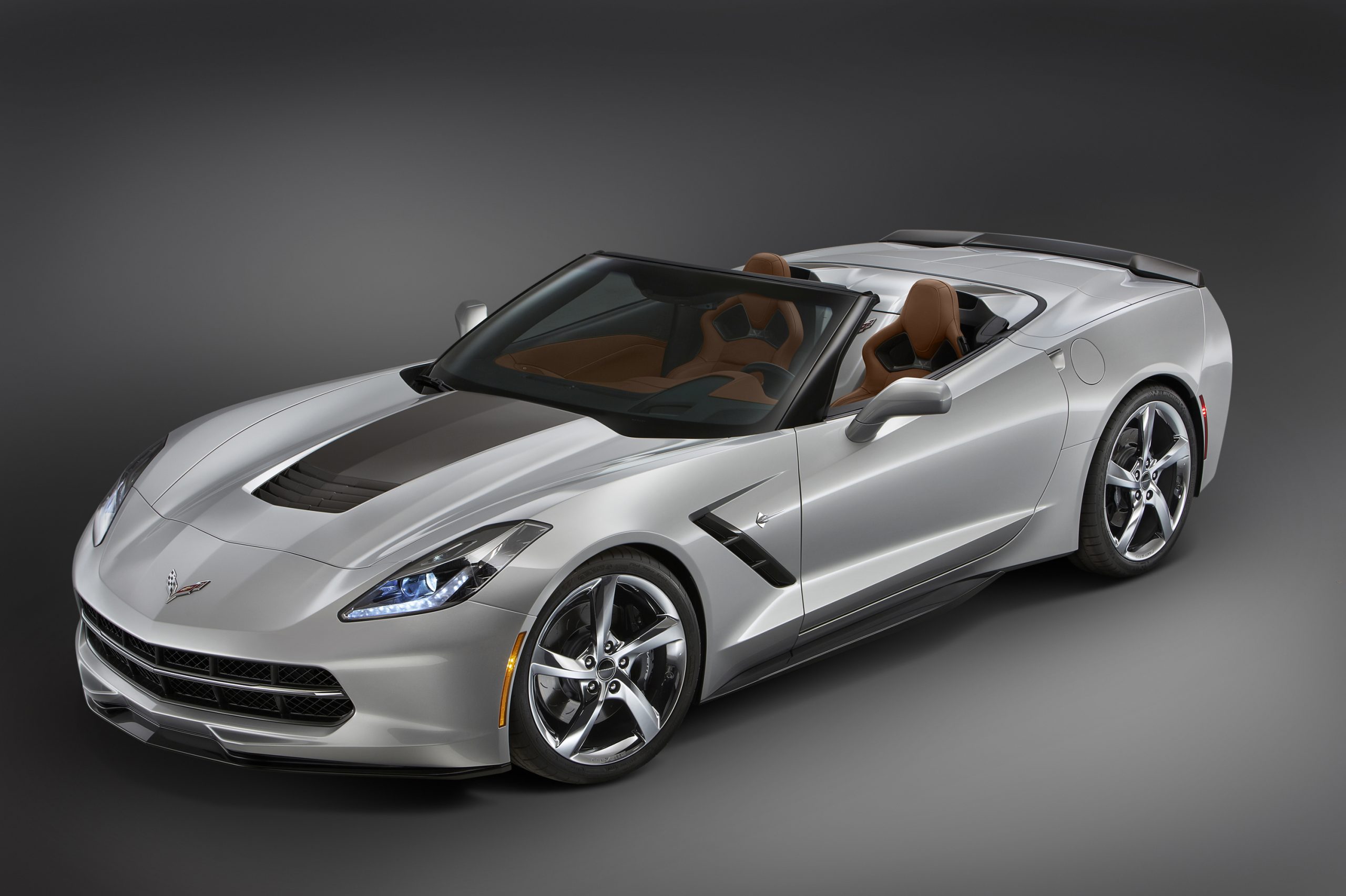
The Atlantic Design Package
The Atlanta Design Package was offered exclusively on Z51-equipped Stingray convertibles. The package was inspired by the luxury and performance of private jets seen at European vacation destinations. The package could be ordered in 2LT or 3LT trims, and included the following unique features and content:
- A front Z06-style splitter, Shark Gray exterior vents.
- Hood “stinger” graphics and tonneau inserts.
- Chrome Torque wheels with Stingray center caps.
- A “Stingray” underhood liner and floor mats.
- Custom splash guards.
- A custom rear license plate frame.
- Stingray logo valve stem caps.
- Custom luggage to accompany the car.
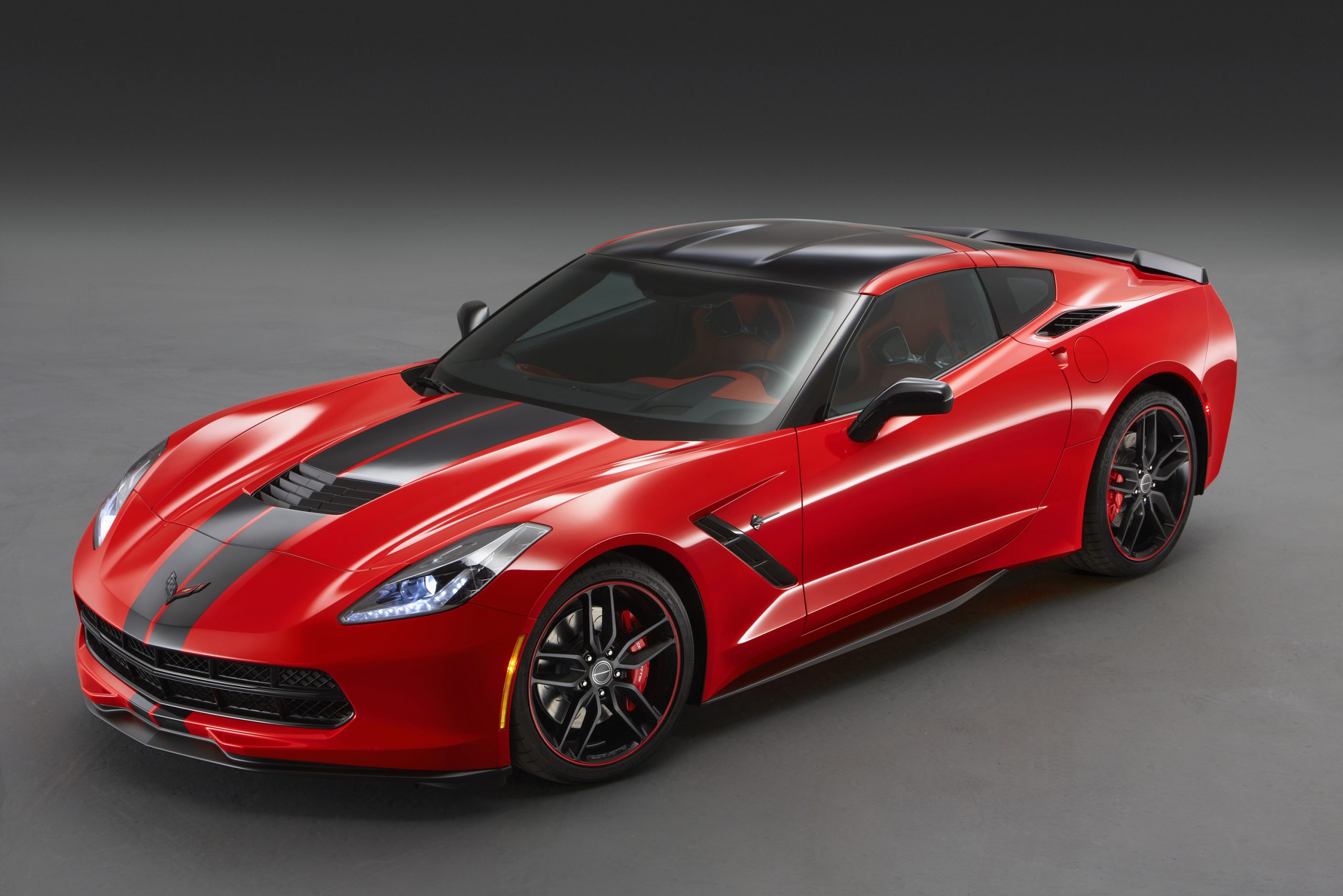
The Pacific Design Package
By contrast, the Pacific Design Package was inspired by West Coast drivers known for attending weekend track events. The package was offered exclusively on Z51-equipped coupes with either the 2LT or 3LT trim levels and included the following unique content:
- Satin Black full-length racing stripes.
- Satin Black Z51 wheels with red stripe and Stingray center caps.
- The “CFZ” carbon fiber ground effects package and visible carbon fiber roof panel.
- A Carbon Flash rear spoiler, outside mirrors and exterior badges.
- Red brake calipers.
- Competition Sport Seats in either red or black.
- Carbon fiber interior trim.
- Stingray sill plates and Stingray floor mats.
- Custom splash guards and rear license plate frame.
- An indoor gray car cover.
The Atlantic Design Package could be ordered in any of the color choices offered for the 2015 model year. The Pacific Design Package was a bit more limited – available colors included Torch Red, Black, Arctic White, Blade Silver and Shark Gray (a new color for the 2015 model year.)
“We plan to make news with the Corvette Stingray every year, in part by offering special-edition models that offer a unique, personal ownership experience. Our customers have told us they appreciate these limited-edition models, which have become an important part of the Corvette’s legacy.”
-Todd Christensen, Corvette Marketing Manager
While the Atlantic and Pacific Design Packages certainly afforded consumers the option of “tailoring” their Corvette to their unique driving experience preference, the reality was that each option was a “check one box” package to purchase either a luxury-inspired convertible or a performance-driven coupe.
GM Introduces an 8-Speed Automatic Transmission
While a desirable option for many consumers, the majority of Corvette enthusiasts still enjoyed the prospect of designing their own vehicle from the ground-up, a tradition that began with Zora Arkus-Duntov enabling consumers the ability to design track-capable Corvettes back in the late 1950’s by selecting the correct RPO’s (Regular Production Options). As such, the 2015 Corvette featured a number of notable improvements over its inaugural model year.
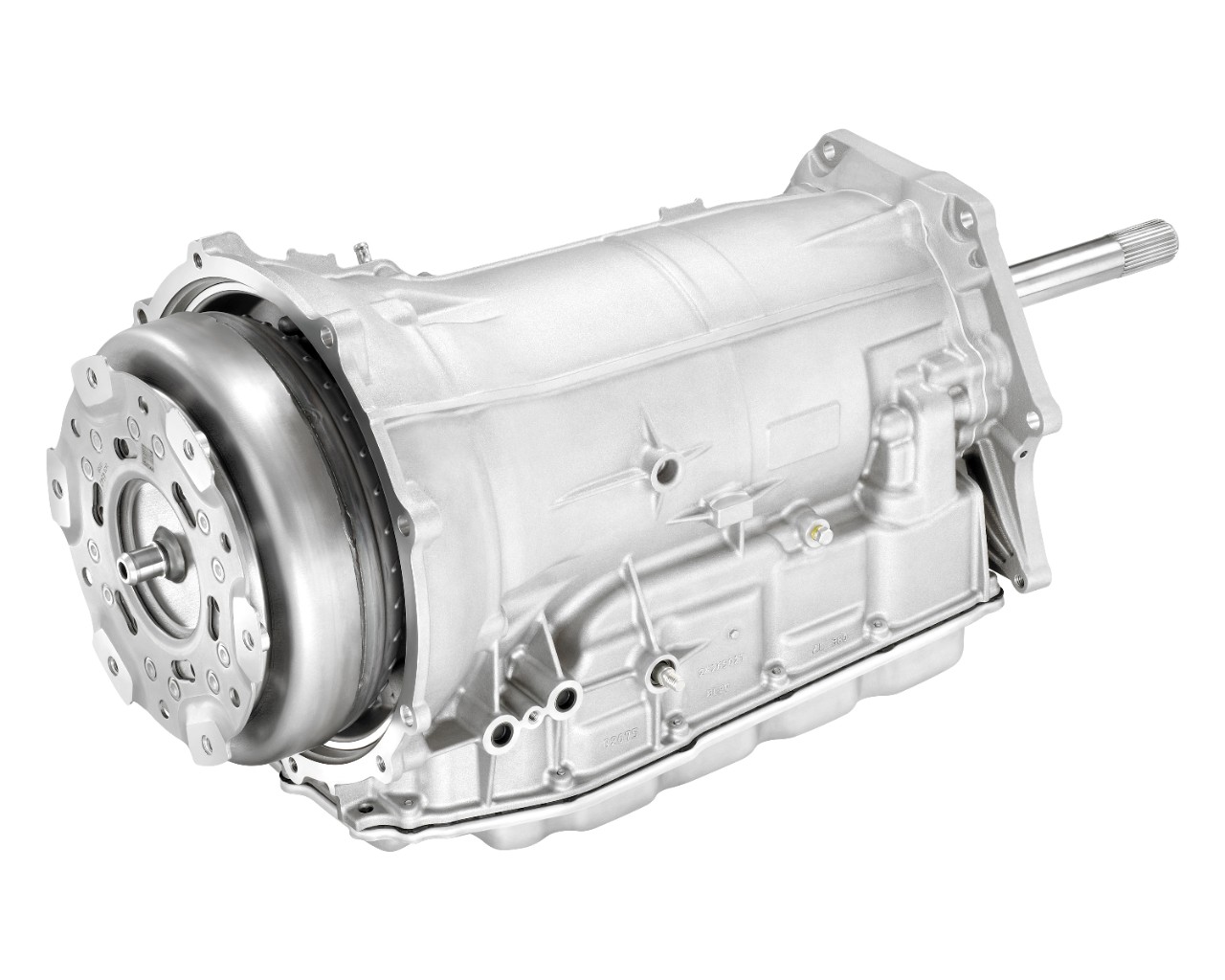
The most notable improvement available to the 2015 Corvette was the introduction of an all-new eight-speed paddle-shift automatic transmission. This transmission, which replaced the six-speed automatic featured in the 2014 model, was offered on both the Corvette Stingray as well as the 2015 Z06 coupes and convertibles. The transmission, dubbed the Hydra-Matic 8L90, was developed and built by General Motors, and delivers world-class shift times that rival the best dual-clutch designs anywhere in the world.
But Is It Fast?
As originally reported in a post from General Motors Media Division, the Hydra-Matic 8L90 is the perfect combination of performance and efficiency. The transmission enables the 2015 Corvette Stingray to achieve a class-leading 29 miles per gallon (EPA highway estimate). It also provides world-class shift responsiveness – producing a documented 0-60 time of just 3.7 seconds and delivering wide-open-throttle upshifts quicker than those offered by the Porsche 911.
The eight-speed automatic features four gearsets and five clutches (including two brake clutches and three rotating clutches). All of this is carefully packaged into a creative casing that enables the new eight-speed automatic to fit in the same space as the previous six-speed automatic. Extensive use of aluminum and magnesium throughout the transmission make it more than eight pounds (4kg) lighter than the six-speed.
“GM’s new 8L90 eight-speed automatic represents a rare win-win-win scenario for customers. It offers greater performance and efficiency, while weighing less than the transmission it replaces. That’s a rare accomplishment in the industry today – and one for which GM has been awarded more than two dozen patents.”
– Kavoos Kaveh, Global Chief Engineer For Eight-Speed Automatic Transmissions
Car and Driver Magazine tested several Corvettes fitted with the new eight-speed automatic transmission. They recorded the same 3.7-second 0-to-60-mph in the 2015 convertible that they had in the 2014 model equipped with the six-speed automatic. However, as the cars approached 80 miles per hour, the newer Corvette began to pull away, and by 150 miles per hour, the 2015 Corvette edged out ahead of the 2014 model by a 0.7-seconds lead time.
The Performance Data Recorder
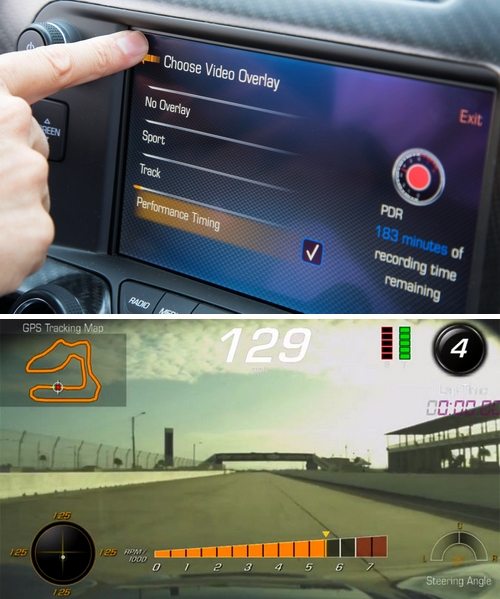
Moving to the interior of the car, the other significant technology advancement on the 2015 Corvette was the introduction of an optional Performance Data Recorder, a feature that came bundled with the navigation system (RPO IO6).
The Performance Data Recorder – or PDR – enables users to record high-definition video, with telemetry overlays, of their driving experiences both on and off the track. The PDR was developed for Corvette in conjunction with Cosworth, the motorsports-engineering company that supplies the Corvette Racing team’s data acquisition and telemetry electronics system.
Developed the year prior to its introduction in the 2015 Corvette, the Performance Data Recorder was named “Best Automotive Electronics Product” at the 2014 Consumer Electronics Show.
The PDR is comprised of three major components:
- A high definition camera which is mounted within the windshield header trim and used to record the driver’s point-of view through the windshield. Audio is recorded via a dedicated microphone in the Corvette’s cabin.
- A self-contained telemetry recorder, which uses a dedicated GPS receiver which allows for more precise positioning and corner traces.
- A dedicated SD-card slot in the glove box for recording and transferring video and vehicle data. Recording time depends on the capacity of the memory card, but an 8-GB card can record approximately 200 minutes of driving time.
How the PDR Benefits Drivers
The PDR system records video and offers driver the option of overlaying the video image with four different pre-packaged data options, each of which is rendered with the video in real time, capturing and providing feedback to drivers. These options are:
- Track Mode– shows the maximum level of data on the screen, including speed, rpm, g-force, a location-based map, lap time and more.
- Sport Mode– shows fewer details on the overlay but includes key data including speed and g-force.
- Touring Mode– simply records and displays video and audio of the drive with no data overlay.
- Performance Mode – records performance metrics, such as 0 to 60 mph acceleration, 1/4-mile speed and elapsed time, and 0-100-0 mph runs.
The video can be viewed on the Corvette Stingray’s eight-inch color touchscreen (while the car is parked) and can also be downloaded to a computer for editing, more detailed analysis, and for sharing with other drivers via social media sites. For drivers looking to gain a greater understanding of their driving behaviors and performance, the PDR data can also be opened in the included “Cosworth Toolbox” software, a professional-level motorsports data analysis software suite used by race teams around the world.
Additional Options Introduced On the 2015 Corvette Stingray
In addition to the optional Performance Data Recorder, the 2015 Corvette came equipped standard with OnStar which included 4G LTE and a built-in Wi-Fi Hotspot. The new OnStar package was specifically designed to enhance Corvette’s connectivity, and provide a mobile hub for both drivers and passengers with easy access to services that required a high-speed data connection. The “always on” wireless connection would enable passengers to enjoy uninterrupted connectivity, even on day-long outings. At the time of purchase, all 2015 Corvettes included a 3GB/three-month data trial.
Other available options on the 2015 Corvette included:
- New wheel finishes for all models, including those equipped with the Z51 Performance Package.
- Carbon fiber tonneau inserts for convertible models.
- Carbon Flash exterior badges.
- Body-color or Shark Gray exterior vents.
- A carbon fiber ground effects package (RPO CFZ).
- The ZF1 package which included Z51-style wheels and spoiler without the Z51 Performance Package.
- Suede-wrapped upper interior trim (on cars equipped with the 3LT package).
- Performance exhaust (included with the Z51 Performance Package).
- Two new exterior colors – Shark Gray Metallic and Daytona Sunrise Orange Metallic.
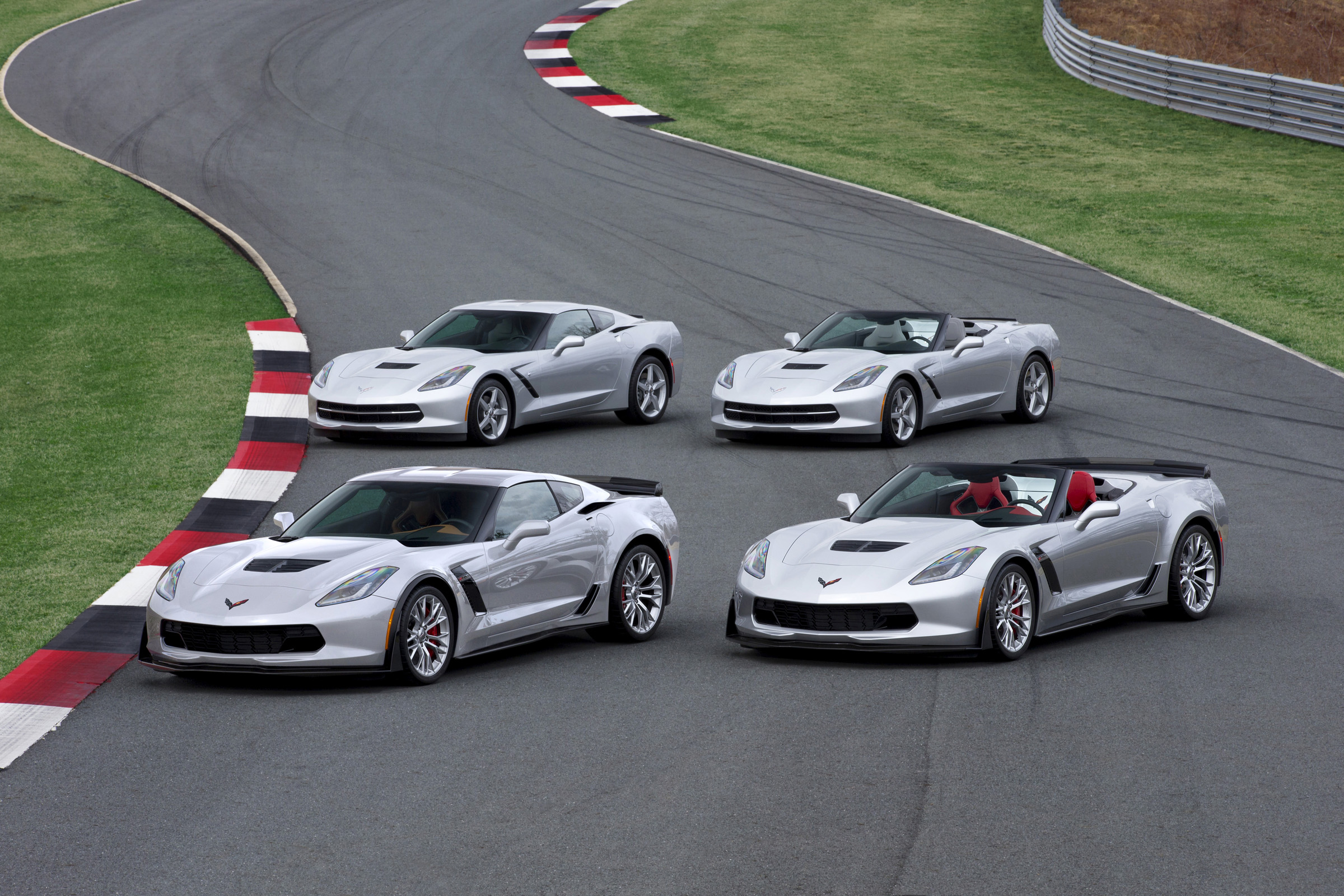
The Return of the Z06 Corvette
While all the enhancements to the 2015 Corvette Stingray coupe and convertible models helped to further advance the car’s perception on the marketplace as a performance vehicle, Chevrolet also unveiled an all-new Z06 model for the 2015 lineup that was more powerful than any production Corvette that had come before it.
“Our mission with the seventh-generation Corvette was to make the performance levels more accessible, enabling drivers to exploit every pound-foot of torque, every “G” of grip and every pound of downforce. It’s a philosophy we introduced with the 460-horsepower Corvette Stingray – and one that’s even more relevant with 650 horsepower at your beck and call.”
– Tadge Juechter, Corvette Chief Engineer
At its unveiling, and all subsequent media related to the car, Chevrolet boasted that the 2015 Z06 Corvette was “the most track-capable Corvette ever.” This certainly proved to be true, and it would take enthusiasts virtually no time at all to realize that Chevrolet had not only built a high-performance variant of the coupe/convertible model, but rather a supercar that rivaled virtually any driving machine on the planet.
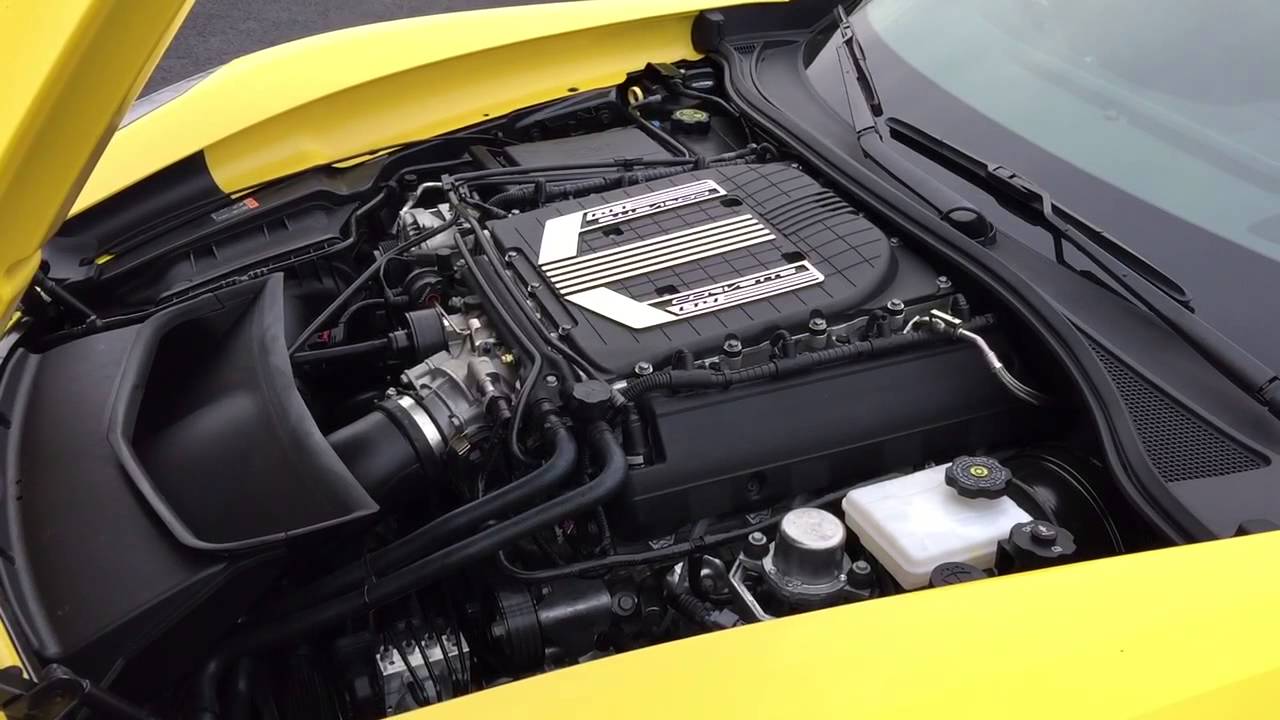
The LT4 6.2L V-8 Engine
At the heart of the 2015 Corvette Z06 was a new LT4 supercharged 6.2L V-8 engine. The LT4 was SAE-certified at 650 horsepower (485 kW) at 6,400 rpm and 650-lb-ft of torque (881 Nm) at 3,600 rpm. This certified performance rating identified the Z06 Corvette as not only the most-powerful production car ever built by General Motors, but also one of the most powerful production cars available in the United States. Consider these numbers (when equipped with the available Z07 package):
- 0-60 mph acceleration in 2.95 seconds with the eight-speed automatic and 3.2 seconds with the seven-speed manual transmission.
- Quarter-mile times of 10.95 seconds at 127 mph with the eight-speed and 11.2 seconds at 127 mph with the seven-speed transmission.
- a lateral acceleration of 1.2 g.
- 60-0 mph braking in only 99.6 feet – the best of any production car tested by General Motors.
In addition to its blistering acceleration numbers, the 2015 Z06 Corvette was also recognized for stretching the performance envelope of the Corvette with unprecedented levels of aerodynamic downforce.
It was the first Z06 to be offered with a supercharged engine (a distinction formerly reserved for the previous-generation’s ZR1 offering), a removable roof panel (thanks to a stronger aluminum frame) and, perhaps most noteworthy, it was the first Z06 to feature an eight-speed automatic transmission.
A Z06 Convertible?
It was also the first Z06 since 1963 to be offered as either a coupe or a convertible. While the 1953 Corvette was originally introduced as only an open cockpit roadster, increasing horsepower and torque caused the integrity of earlier Corvettes to suffer during extreme driving conditions. It was only thru recent technical advancements made by GM’s engineering team that the new Z06 could once more be sold as either a coupe or convertible.
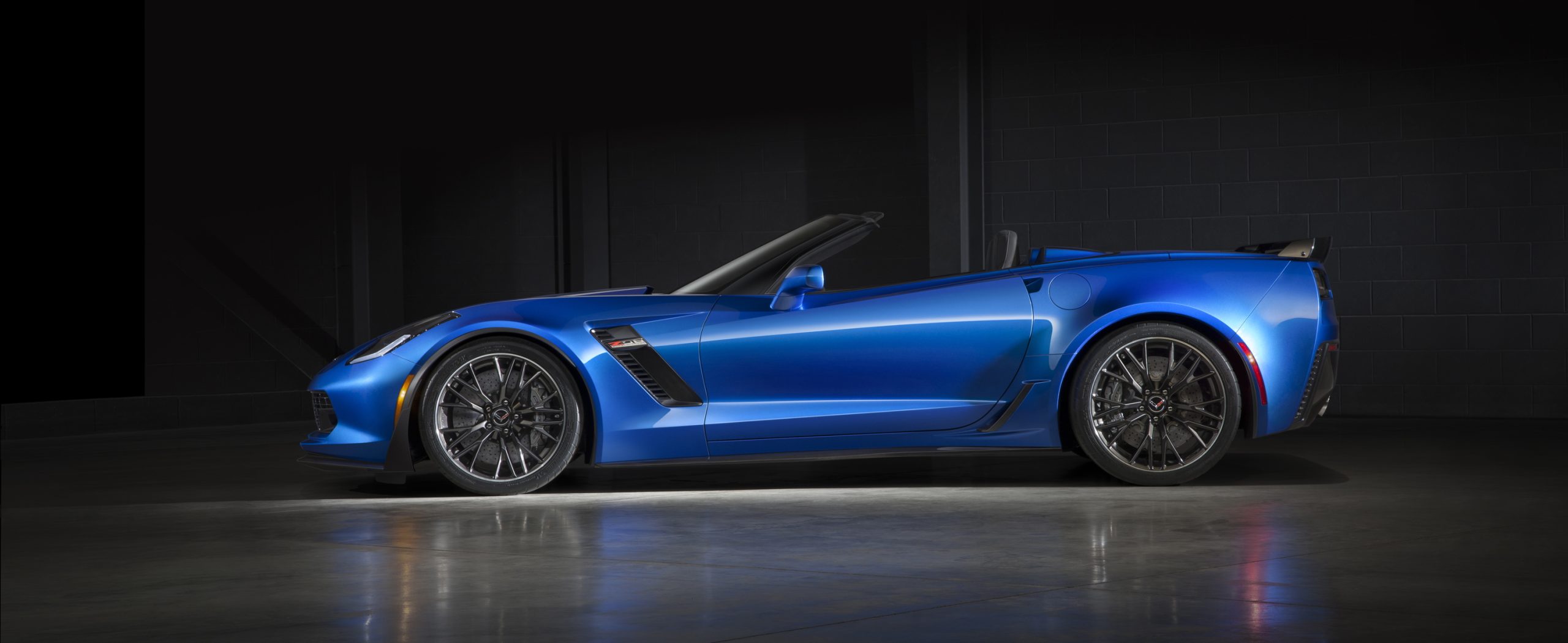
“Simply put, until recently it was not possible to create an open-roof structure strong enough to meet Corvette’s highest performance levels. It required advancements in computer-aided engineering, metallurgy and manufacturing – many of which did not exist five years ago – to make a frame strong enough for a Z06 Convertible.”
– Tadge Juechter, Corvette Chief Engineer
The new aluminum structure was engineered to be 20 percent stiffer than the previous, fixed-roof Z06. As there were no structural reinforcements needed for the Z06 Convertible, it curb weight wass nearly identical to the Z06 Coupe. Both versions of the car also shared the same chassis tuning, powertrain output, driver technologies and equipment options – which included a track-focused Z07 Performance Package.
The Z07 Performance Package
While the Z06 Corvette was a powerhouse that rivaled the C7.R Corvettes that were being developed as part of the racing program, Chevrolet also recognized the importance of building a platform that enabled drivers of all levels the capabilities of maximizing the performance they got out of their cars.
The Z07 package was introduced as part of the 2015 Corvette Z06 roll-out. The Z06 package added adjustable front and rear aero components to the car. It included adding larger winglets to the front splitter, along with an adjustable, see-through center section on the rear spoiler for track use. With this package, the Corvette Z06 delivered the most aerodynamic downforce of any production car GM has tested.
Where Rubber Meets the Road
The all-new Z06 Corvette also featured Michelin Pilot Super Sport Cup tires for enhanced grip. The front tires – P285/30ZR19 – are 1.5 inches wider than those found on the base Stingray, while the rear tires – P335/25ZR20 – are actually two inches wider! In addition, the car was introduced with carbon ceramic-matrix brake rotors that dramatically improved braking performance and directly contributed to greater handling.
To account for the wider tire tread, the fenders of the Z06 were extended by 2.2 inches (56mm) in the front of the car, and 3.15 inches (80mm) in the rear. These fender extensions gave the Corvette Z06 a wider, lower appearance which was further emphasized by a unique rear fascia. While the Z06 incorporates the same taillamp assemblies found on the Corvette Stingray, the taillamp assemblies are pushed approximately three inches farther apart. This wider stance – which tracks the C7 Corvette’s mantra “form follows function” – also demonstrates a further connection between the production car and the C7.R race car.
“Form Follows Function”
“Practically every exterior change served a functional purpose, as this beast needed more of everything. The flared fenders accommodate larger, wider wheels and tires for more grip. The larger vents provide more cooling air to the engine, brakes, transmission and differential for increased track capability. The more aggressive aerodynamic package generates true down-force for more cornering grip and high-speed stability.”
– Tom Peters, Corvette Design Director
“The Corvette Z06 is a great example of the technology transfer between racing and production Corvettes. First, we took what we learned on the Corvette Racing C6.R and applied that to the all-new Corvette Stingray. Then, using the Stingray as a foundation, the Z06 and C7.R were developed to push the envelope of performance on the street and the track.”
– Tadge Juechter, Corvette Chief Engineer
While the 2015 Z06 Corvette was developed specifically for track-ready, high-performance driving capabilities, the interior of the car was also developed in conjunction with the C7 Stingray to offer drivers a level of luxury that had been notably lacking from earlier iterations of the Corvette.
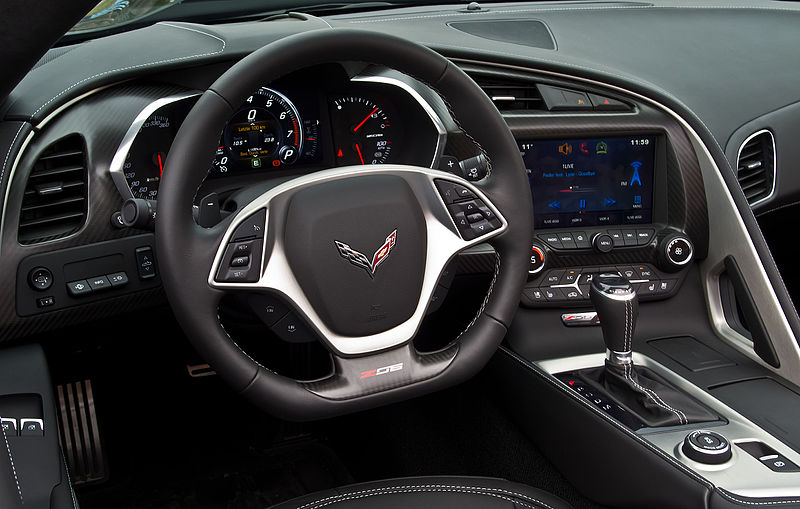
Inside the Cockpit
The interior of the Corvette Z06 is distinguished from the Stingray by unique color schemes that emphasize the driver-focused cockpit. Additionally, the Z06’s steering wheel features a flat-bottom design synonymous with the steering wheels used in the C7.R racecar. Like the Stingray however, the Z06 offered two seating choices – the GT seat, which was designed for all-around comfort, or the Competition Sport seat, which features more aggressive side bolstering intended to provide greater support at the racetrack.
Both the Z06 and Stingray models feature a fully-wrapped interior full of premium, soft-touch materials (varying only by the selected trim level purchased.) These materials included Napa leather, aluminum, carbon fiber and micro-suede. A sueded microfiber-wrapped upper interior trim package was featured on Z06 Corvettes equipped with the 3LZ option. The 3LZ trim package included a sueded microfiber headliner, visors, trim above the windshield and rear window, A-pillar trim and the area around the quarter window. An additional appointment of luxury was the introduction of a micro LED screen placed below the vent on the dashboard that enabled the passenger to adjust climate control independently from the primary instrument panel.
The Z06 Corvette interior came in one of five colors: Dark Gray, Blue, Jet Black, Kalahari and Adrenaline Red.
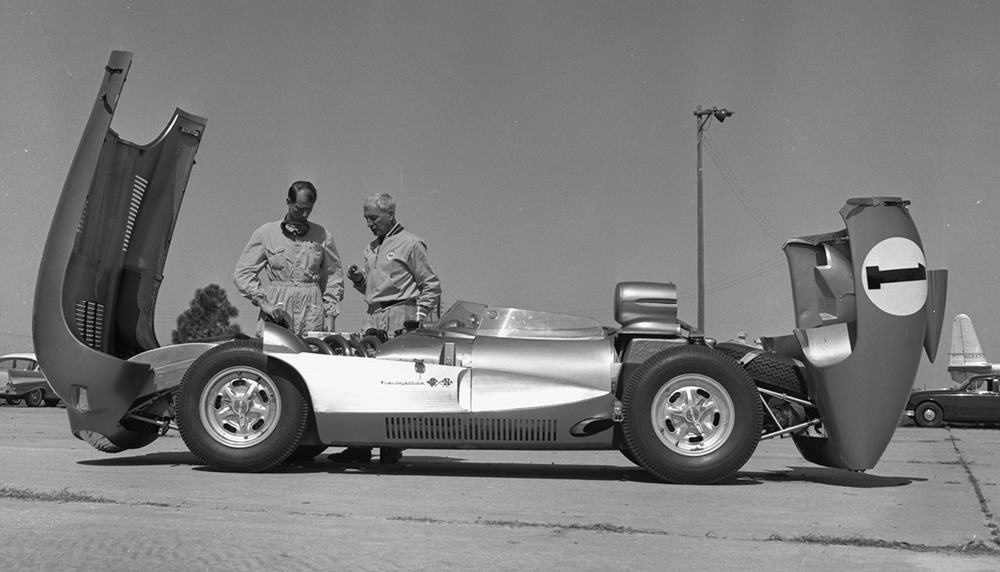
On The Track
In the history of the program, the Corvette’s un-yielding connection between the race track and production car has long been well established. Zora Duntov’s earliest efforts to bring the Corvette to the world stage as a serious racing machine catapulted the Corvette onto the track and helped it gain credibility at venues it might otherwise never have made an appearance.
In Europe, where road course racing was (and is) far more dominant than in the United States, Duntov’s insistence on building a high-quality – yet affordable – racecar helped Corvette become the car it is today, and to establish Chevrolet – an American manufacturer of low-priced automobiles – as a rival of such manufacturers as Porsche, Lamborghini and Ferrari.
The 2015 24 Hours of Le Mans
In 2015, the Corvette Racing program celebrated its long history with another class win at the 24 Hours of Le Mans. The No. 64 GTE Pro C7.R race car, driven by Oliver Gavin, Tommy Milner and Jordan Taylor, took the checkered flag after a disappointing seventh-place qualifying run just 24 hours before. The victory, which saw the Corvette Racing program come back from a great deal of adversity throughout the week leading up to the race (including retiring the No. 63 Corvette after a small piece of debris inside the pedal box caused the throttle to malfunction and the Corvette to skid and spin out of control.)
The No. 63 and No. 64 Racing Teams at the 24 Hours of Le Mans.“I am proud of how the No. 63 and No. 64 drivers, engineers and crew came together to rally around a single Corvette C7.R entry for the race after Thursday’s unfortunate incident.” Said Jim Campbell, Chevrolet U.S. Vice President, Performance Vehicles and Motorsports. “They prepared thoroughly and had each others’ back all race long. Perseverance, teamwork and execution were keys to the winning effort.”
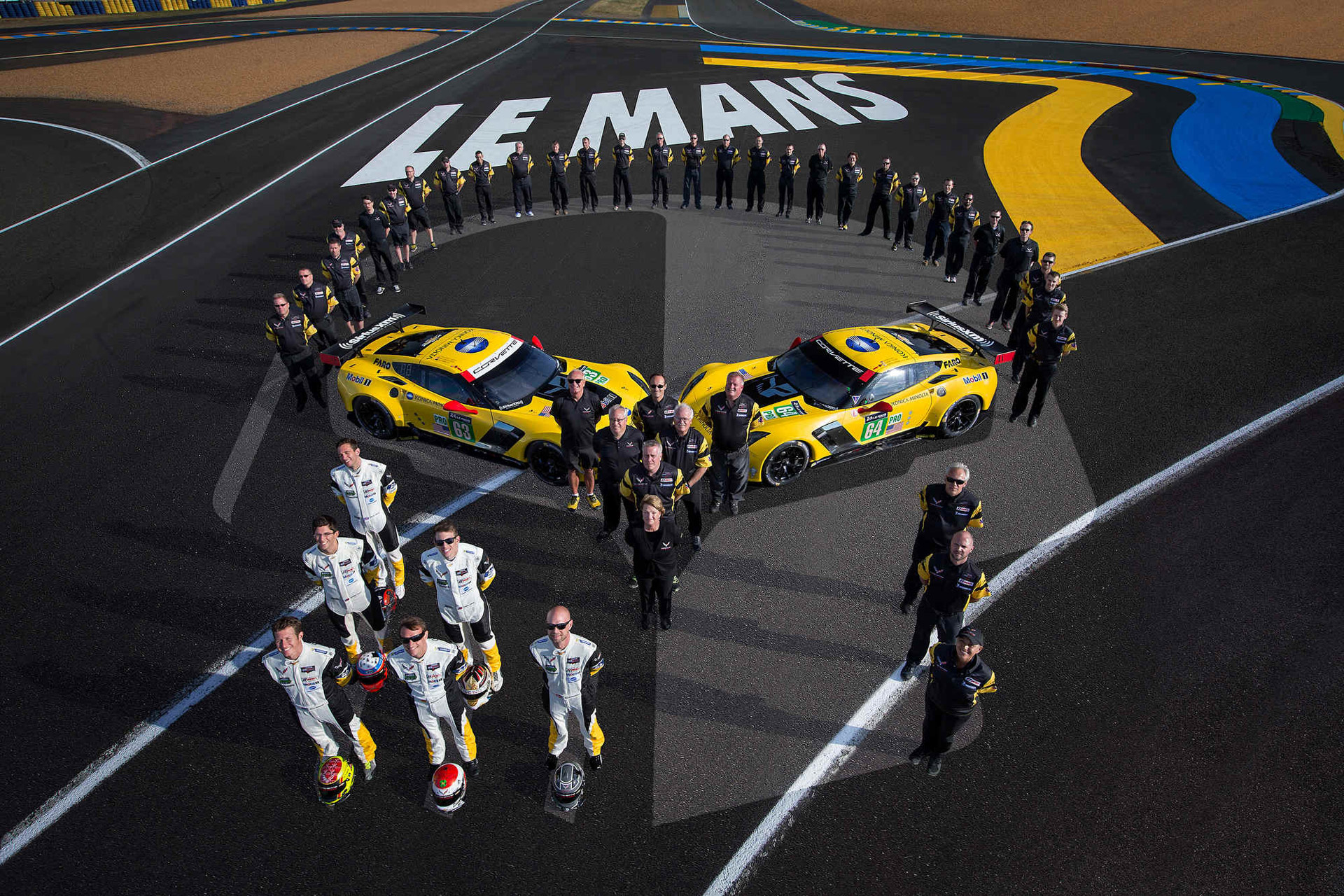
Perhaps one of the greatest, most significant moments of the 2015 24 Hours of Le Mans race happened off of the racetrack. To understand it, you must first understood that, for generations, many key European automotive enthusiasts have shunned the Corvette, stating that it was not on par with anything being manufactured by the Germans, Italians, French or British automotive manufacturers.
At the 2015 24 Hours of Le Mans, Corvette and Chevrolet owners showed up in such force, that the Corvette Corral – an area at the track designated for Corvette owners to showcase their vehicles – was completely full. Consider that the 24 Hours of Le Mans is held every year in Le Mans, France, and it becomes clear that the Corvettes on-show in the corral that year were not owned by Americans, but rather by European nationals who had driven their American Sports Car with pride to one of the greatest international racing events in the entire world!
2015 Corvette Gallery
See full 2015 C7 Corvette Image Gallery


